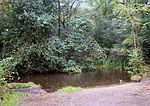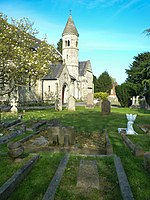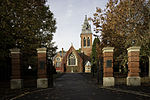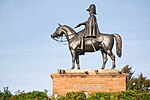Blackwater Valley Path
Footpaths in HampshireFootpaths in SurreyHampshire geography stubsLong-distance footpaths in EnglandSurrey Heath ... and 1 more
Use British English from February 2017

The Blackwater Valley Path follows the River Blackwater from its source in the Rowhill Nature Reserve in Aldershot to just beyond the point where it joins the River Whitewater near Swallowfield to become the Broadwater. This long-distance route covers 23 miles (37 km) and closely follows the River Blackwater using public rights-of-way as well as permissive footpaths and is waymarked. It is looked after by the Blackwater Valley Countryside Partnership.The Surrey Heath section includes informal parks on reclaimed land at Blackwater Park and Watchmoor.
Excerpt from the Wikipedia article Blackwater Valley Path (License: CC BY-SA 3.0, Authors, Images).Blackwater Valley Path
Farnborough Road, Waverley
Geographical coordinates (GPS) Address Nearby Places Show on map
Geographical coordinates (GPS)
| Latitude | Longitude |
|---|---|
| N 51.24 ° | E -0.786 ° |
Address
TGA Living
Farnborough Road 174
GU9 9AX Waverley
England, United Kingdom
Open on Google Maps








